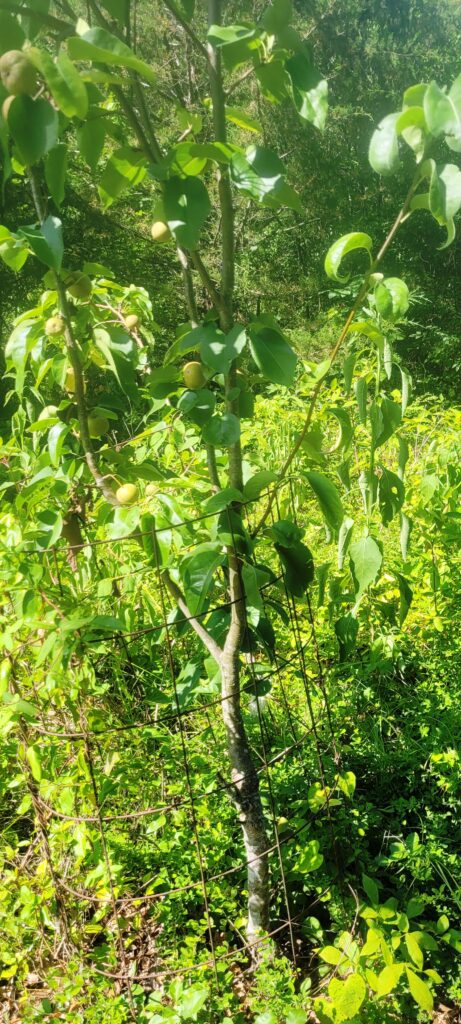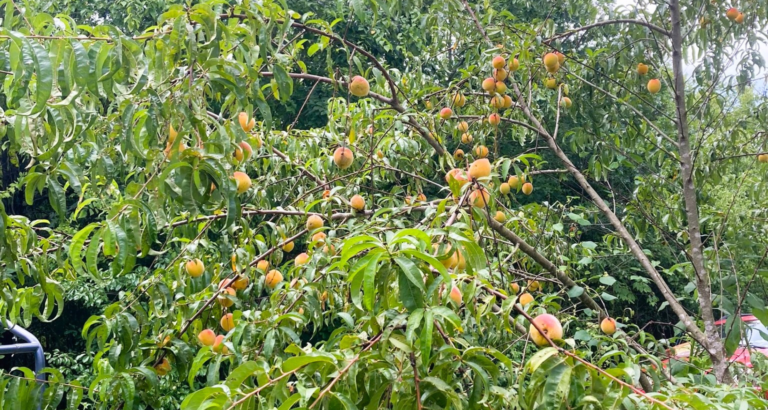A Tale Of A Pair of Pears: Find The Good In The Bad
Invasive species — plants not from our part of North America, that take over and crowd out beneficial plants -are something native tree and wildflower fans fight against. One of the worst is the Bradford pear, aka Callery pear (Pryus calleryana), Cleveland pear, or Plymouth pear. Yet we’ve discovered how having a pair of pears helps us find the good in the bad.

I won’t take a lot of time talking about Bradford pears. Still sold in big box store nurseries such as Walmart, Lowe’s, Home Depot, and others, they appear to be beautiful and healthy. They grow quickly, have nice leaves, and during the Spring, our area near Chattanooga is bursting with their white blossoms.
That’s where their beauty ends. Much has been written about what a pest they are. Like most invasive, non-native trees, they crowd out good trees, taking over entire forests with their fragile wood, smelly flowers and thorned tree branches. In fact, in the Southern USA they are so problematic that some states, including North Carolina, offer a bounty on their removal!
A Pair Of Pears Solution
As we looked at the dozens of Bradford pear trees that sprung up, uninvited, at Spirit Tree Farms, we saw the huge task in front of us. Cutting down and pulling out these trees would take a long time, and would probably only encourage their roots to sprout multiple trunks. Then my brother (the other Nature’s Guys) near Seattle wondered: Could fruiting pear tree scions be grafted onto Bradford pear trunks?
Going to YouTube, we discovered that it was indeed possible. We immediately began gathering scion branches from fruit pears we liked, including Bartlett, Moonglow, and others. My brother brought me some scions from his favorite pear tree, a sweet, round Asian pear.
Guess what? Almost every type of scion was successfully grafted onto Bradford pears. Even more exciting was the appearance this year of dozens of Asian pears (my wife’s favorite) within walking distance of our house. While making a video about the pair of pears, I was pleased to discover another tree, grafted onto Bradford pear rootstock, heavily laden with Asian pears.
Other pear types been successfully grafted onto the Bradford pear trees, but have not successfully fruited yet. Still, another benefit of this pair of pears solution is heirlooms. We were able to get some scions from a dear friend’s farm orchard, just before he sold it and passed away. They were actually the first successful pear grafts we had. Although they haven’t fruited yet, it’s still gratifying to walk by a large, healthy fruit tree and think “There’s Hayden’s pear tree!”
Lesson From Nature: Even Bad Can Be Good
It seems we’re often finding these lessons from God in Nature: When we look for the positive, we can find it. Or, as others have said, make lemonade out of lemons! (Or, in this case, try a pair of pears!)
Would you like to do a Nature observation walk and learn not only how to find and identify invasive species, but find a solution for them. Do you want to find God’s peace in Nature, and increase your observational and creative skills? Check out Spirit Tree Farms creativity and nature observation courses, or contact us.


